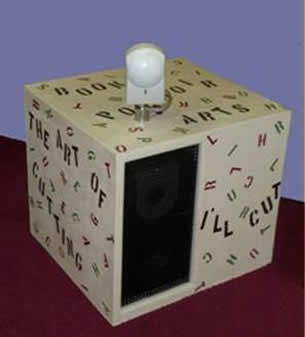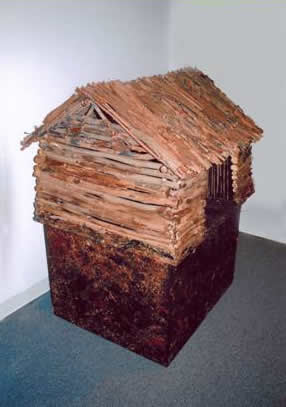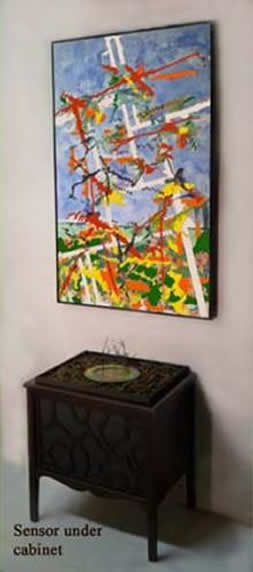

Interactive Sculptures -
In recent years, in addition to doing larger installations, I have been developing individual interactive sculptural pieces. This has been made possible by the development much smaller computers than I had used in my earlier installations. However, there is a similar aesthetic, but they are more intimate than the larger installations. Some are presented below.
What Is Was. This is an interactive sound sculpture based on a mix of personal and public history. The sounds are produced by a computer and audio speaker system housed in the refurbished radio cabinet. The system is triggered by people moving in front of the cabinet. Each time the system is triggered a different selection of sounds (2-5) is heard in a random and sometimes overlapping, nonlinear mix of impressions. The sounds are spoken words about personal and public history. They are heard coming form the reconstructed cloth covered area below the dials on the front, where the original speaker was located.
 A selection is given here -
A selection is given here -
War declared today.
George, young, broke his left collar bone.
There was a civil rights march in town.
Birthday cake with green icing
President Kennedy was assassinated.
Boys can hardly wait for Christmas.
The Berlin Wall came down.
Boys marched in parade to cemetery.
Hiked in woods this afternoon
Martin Luther King assassinated yesterday.

A Tribute to the Art of Cutting was made specifically for the exhibition” I’ll Cut ThrU” which was held at the Center for Book Arts, NYC in 2010, and then traveled to Sarah Lawrence College. The interactive sculptural book was designed as an introduction to the exhibit of books, all of which involved cutting in some fashion. The sculpture was placed at the entrance to the exhibit, where people triggered it as the came in. This interactive sculpture housed a computer, sampler and speaker with the sensor mounted on top. When triggered the sculpture produced random sequences of voice segments, which were edited versions of comments about the exhibit, recorded in interviews with the two curators of the exhibition. In this piece the voice segments overlapped a great deal, crating more of a texture of sound than clearly recognizable words. In addition there were samples of sounds made by cutting machines.
 Some of the comments were:
Some of the comments were:
1) All artists do books - something that contains information - all
artists want to make a book
2) The concept of the book and book arts within the broader
context of contemporaryliterary arts
3) Cut out dolls - the prints called topsy turvey
4) She is trying to capture the minority cultures of China – this
concept of memory and loss
5) Show coherently or cohesively how different methods of
cutting can create intellectual, meaningful,
content-driven art objects
6) With the print, you see the cutting action, the marks, through
the wood, made by the tools on the block
7) Pochoir, I’ll cut through, pochoir carving, cutting, altered book
and new media
8) Conception, process, I’ll cut through conceived in duality
9) The idea of cutting, the objective of cutting, carving,
applications of cutting

Sheltering Hut The sculpture uses the metaphor of a hut as providing the interface between our inner lives and the external world. The computer and sampler are inside the base. A speaker and a sensor are inside the hut, hidden from view. The system responds to viewers’ movements by generating voice phrases. Each time it is triggered, a different randomly selected sequence of 2-5 phrases is heard. Some of he phrases overlap in time.

Some of the phrases are:
1) Shelters are imperfect protection
2) Integrating the inside and the outside
3) Outside is public
4) Inside is private
5) Let the outside go in
6) Let me gain inner strength
7) Happiness can be inside or outside
8) The shelter as a retreat
9) Working through my inner challenges
10) Reflect on the outside while inside
11) Facing the conflicts of the outer world
12) Translation through the walls

Seeing the Landscape from within. Two interrelated pieces, the painting and the cabinet, form and interactive sound sculpture about seeing the external world through internal perceptual/neural processes.
A computer, a sampler and a speaker are inside the cabinet. A sensor is under the cabinet, hidden from view. It responds to viewers’ movements by causing the system to generate voice phrases. Each time it is triggered, a different random sequence of 2-5 phrases (is 25 possible phrases) is heard. The phrases partially overlap in time.

Two phrases are printed on the painting –
1) Seeing the landscape from within
2) Neurons organize my view
Some additional phrases are:
3) How do we see?
4) Inside and outside
5) Perception – interaction with the world
6) Where does the landscape exist?
7) Mapping the outer landscape on our inner neural landscape
8) Understanding – feeling – interacting-
9) Organizing - knowing – experiencing
10) Our neurons speak of the land.


Keeping and Throwing Away. This is an interactive sculpture that explores our attachment to material objects. The sounds are produced by a computer and sampler housed in the base out of sight. The speaker is hidden under the shelf and other material in the back , in order that it is able to produce clear sounds without being obvious. As indicated in the photo, on the front is mounted a senor, which when activated produces the sounds. Each time the system is triggered a different selection of sounds (1-4) is heard in a random, sometimes overlapping mix of impressions. The sounds are spoken words about throwing away and keeping material objects.
 A selection of the 16 samples is given here:
A selection of the 16 samples is given here:
1) Why keep that?
2) It belonged to my great grandmother.
3) We need to clean out all of this junk.
4) This is a memento of the great time that we had
5) I may need it for something.
6) It is my good luck charm.
7) Toss it. It is just taking up space.


A Witness for the Past is an interactive sculpture with a sensor, a speaker sampler and computer housed in the base. It responds to viewers’ movements by generating a randomly selected sequence of voice segments. Sometimes the segments overlap in time. There are 24 voice segments.
 Some are included in the following:
Some are included in the following:
1) Seeing the past
2) Remember the storm
3) If monuments could talk
4) A witness for our memories
5) Battered but standing through it all
6) Uplifting thoughts remain
7) The past is there for us to know
8) The soft rain of a summer night
9) How have we changed?
10) History forms the memories of knowing
11) The chill of an autumn night
12) Butterfly flutter in the sunlight
13) Over there is where it all began
14) Witness, witness, witness
15) Memories turning, knowing what has been
16) New opportunities bring hope
17) All the pieces of world are what they are
18) The breeze of air moves slowly in the heat
19) Song and voices fill the void that is